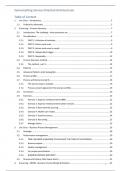Summary
Samenvatting Service-oriented Architecturen
- Course
- Institution
Dit document bevat een volledige samenvatting van de lessen en zelf te bekijken opnames van het vak Service-oriented Architecturen in afwisselend Nederlands en Engels. Op het einde van het document heb ik een aantal tips voor het groepswerk en de presentatie van ons groepswerk toegevoegd.
[Show more]



